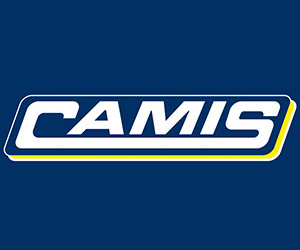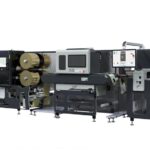World economy lacks vitality and increase of Chinese economy slowed down, showing development of Chinese economy steps into transition period. In recent two years, Chinese macro economy policies changed to focus on adjustment of economy structure, weakening the pursuing of GDP growth rate.
Chinese government adopted many ways to control the increasing rate, and realized stable development. Chinese economy has passed through the phase of rapid expansion in large scale. Under such market situation how is the performance of Chinese printing industry in 2011? Any features were presented? How is the Chinese printing industry in 2012? The following is the basic introduction, based on the data from General Administration of Press and Publication, National Bureau of Statistics and Printing and Printing Equipment Industries Association of China (PEIAC).
Masterwork plant in Tianjin: click to enlarge
 1 – Basic information of Chinese Printing Industry in 2011
1 – Basic information of Chinese Printing Industry in 2011
There were 102.484 printers of all kinds in China by the end of 2011; 3.57 million workers were employed; total output of printing industry was 867.7 billion Yuan; gross value of assets was 925.7 billion Yuan.
6.821 publication printers, total output was 131.3 billion Yuan (taking 15% of output of whole industry). 7.71 billion books, 3.29 billion volume of magazine and 46.74 billion newspaper were printed in 2011 by Chinese printers;
47.377 package and decorating printers, total output was 631.9 billion Yuan (taking 73% of output of whole industry). Chinese printers provide various kinds of package and label for food and beverage, pharmacy, small household appliances, clothes, toys, cultural and sports articles and electronic goods. In 2011, 3 billion square meters of label were produced;
44.868 other presswork printers, their total output was 70.9 billion Yuan (taking 8% of whole industry);
2.676 typesetting, plate making and binding companies, total output was 7.7 billion Yuan (taking 0.8% of whole industry);
799 exclusive and non-exclusive digital printers, total output was 3.974 billion Yuan (taking 0.5% of the whole industry).
Masterwork plant in Tianjin: click to enlarge
 Analysis of the data shows the features of operation of Chinese printing industry
Analysis of the data shows the features of operation of Chinese printing industry
1.1 Chinese printing industry keeps comparatively fast growth
Total output of printing industry was 867.7 billion Yuan in 2011, increased by 12.59% than last year, higher than the increase rate of 9.3% of the national economy GDP. The scale of Chinese printing industry is reaching the second place globally. At the same time, gross value of assets increased by 9.96%; total profit increased by 8.31%. The development of advanced area:
Total output value of printing industry in Guangdong province in 2011 was 160.7 billion Yuan, increased by 6.4% than 2010;
Total output value of printing industry in Jiangsu province in 2011 was 100.1 billion Yuan, increased by 30% than 2010;
Total output value of printing industry in Shanghai in 2011 was 68.95 billion Yuan, increased by 17.72% than 2010;
Total output value of printing industry in Beijing in 2011 was 26.2 billion Yuan, increased by 28% than 2010;
1.2 Package printing is key factor driving high-speed development of Chinese printing
There were about 102.484 printers of all kinds in China by the end of 2011, among them, 47.377 are in package and decorating printing industry, taking 46% of the total number. While total output of printing industry was 867.7 billion Yuan in 2011, total output packaging and decorating printing industry was 631.9 billion Yuan (taking 73% of output of whole industry). We can say package printing already became the pillar of development of Chinese printing industry.
Among the list of top 100 Chinese printers in 2011, 53 are package printers, another 31 companies also involved in package printing. Package printing is the vastest field which top 100 printers involved.
Beijing used to be strong at publication printing, but in 2011, sales of package printing increased by 25%, reaching 10.9 billion Yuan and exceeding publication printing.
1.3 Chinese printing industry is a domestic demand based processing service industry
In 2011 the Chinese printing foreign processing trade was 68 billion Yuan, taking 8% of the total industrial output value of Chinese printing industry. Due to the influence of international demand, exchange rate and rising costs and other factors, the Chinese printing foreign processing trade only increased by 2.9% than the year of 2010. Considering the matching products, the overall proportion of foreign processing trade is far greater than the ratio of 8%, but it’s an indisputable fact that the Chinese printing industry is a domestic demand based processing service industry.
Pearl River Delta region is base of foreign trade printing processing, taking more than 70% of national foreign trade printing processing value. In recent years, processing trade in Shanghai, Jiangsu, Fujian and other provinces also grow rapidly, among them, Shanghai’s foreign trade processing amounted to 6.961 billion Yuan, increased by 50.5% than 2010; foreign trade processing in Jiangsu province in 2011 amounted to 8.07 billion Yuan, increased by 46.2% than 2010.
1.4 Concentration of Chinese printing industry increased rapidly
Seeing from the overall scale, in 2011 Chinese printing industry increased in the area of overall output, capital assets and total profit, at the same time, number of printers and employees were reduced (decreased respectively 1.8% and 2.7% ). This shows concentration of Chinese printing industry increased steadily. On the other hand, there were 2.439 printers above designated size in 2011 (annual industrial output value over 50 million Yuan), their gross value of industrial output was 439.7 billion Yuan.
These enterprises only take 2.4% of the total number of the printing enterprises, but their total production value occupies 50.7% of the whole industry in China. And compared with 2010, number of printers above designated size increased 292, (growth rate is 13.6%), gross value of industrial output increased by 80.5 billion Yuan (growth rate is 22.4%), far higher than the growth rate of national printing industry. Industrial concentration in Chinese printing industry increased rapidly.
1.5 Chinese green printing made important progress
After two years’ implementation of green printing, important achievements have been made in the promotion of energy-saving and emission reduction, adjustment of the industrial structure and benefiting the society. As estimated, energy and material cost were reduced by 500 million Yuan annually through implementation of environment protection; release of VOC reduced 1.5% annually.
Printers with certificate of green printing is over 160, taking only 0.15% of total printers, but their output took 4.5% of the whole industry. More than 1000 kinds, 200 million schools textbooks for autumn of 2012 were processed by green printing, more than half of the country's primary and secondary school students at least got one green printed textbooks in their hands.
2 Chinese printing equipment and material market
2.1 Printing equipment
In 2011 the Chinese printing equipment market reached 50 billion Yuan (about 8.2 billion US dollars). According to the statistics from General Administration of Customs, in 2011, China imported printing equipment for 2.54 billion US dollars, increased by 10.64% than 2010; export of printing equipment was 1.251 billion US dollars, growing 14.12%.
In 2011 Chinese 68 key printing equipment manufacturing enterprises achieved total output value of about 7.813 billion Yuan, growing 16.06%; sales revenue was 7.452 billion Yuan, growing 10.17%; total profit was 615 million Yuan, dropping 3.98%.
2.2 Offset printing plate
In 2011, Chinese offset printing plate consumption was 259 million square meters, including CTP plate consumption of 117 million square meters (CTP taking 46% of the total offset plate consumption). In 2005 CTP consumption was 5.19 million square meters, taking 5% of the total offset plate usage, that is to say, 6 years from 2005 to 2011, the annual domestic consumption of CTP plate grew 20 times.
According to the survey and statistics from Printing Material Sub-association of Printing and Printing Equipment Industries Association of China (PEIAC) to 92 domestic production lines, the total production of offset plate was 371 million square meters in 2011, accounting for about half of global output. Among them, production of PS plates was 193 million square meters; production of CTP plates was 178 million square meters.
China is the biggest offset printing plate production country in the world and also the biggest offset printing plate supplier to the international markets.
2.3 Computer to plate equipment
CTP technology continues to mature and CTP plate price drops substantially, Chinese CTP technology application has entered a period of rapid growth. In 2010 Chinese CTP equipment installation broke through 1000, reaching 1506. In 2011 Chinese CTP equipment installation reached 2000. In 2011 there were 5500 CTP equipments in China.
2.4 Printing ink
In 2011 the domestic printing ink consumption was about 580.000 tons, of which 32.600 tons were imported.
Offset printing ink consumption took about 45% of the total number, gravure printing ink took about 35%. Water based ink and non-benzene has accounted for about 20%.
2.5 Printing paper
In 2011 Chinese paper and paperboard consumption was 97.52 million tons, increasing 6.31% over 2010, per capita annual consumption was 73kg.
Regarding printing related part, consumption of newsprint was 3.89 million tons (decreasing by 8.04%), consumption of uncoated printing paper was 16.87 million tons (growth of 6.10%), consumption of coated paper was 5.32 million tons (growth of 10.83%), and consumption of coated white board paper was 12.72 tons (increased by 5.63%).
3 Chinese printing market in 2012 and the future prospects
3.1 Chinese printing market in 2012
Compared with 2011, Chinese printing industry market went without obvious improvement. Internal industrial overcapacity, pressure from rising labor costs and raw material price still existed. But all these disadvantages promoted the upgrade and structural change of Chinese printing industry.
From January to November in 2012, the total investment in fixed assets of enterprises above designated size in Chinese printing industry reached 97.9 billion Yuan, while it was 87.9 billion Yuan in 2011. Similarly, from January to November in 2012, the monthly industrial added value of enterprises above designated size increased more than 8.3% than the same period in 2011.
From January to November in 2012 import of printing equipment was $1.57 billion, of which import of offset printing machine (1074 ) was $889 million. From the monthly data it can be seen that after the downturn in the first half of 2012, the amount and quantity of imported printing equipment in the second half of the year has restored to the level of the same period in 2011.
In short, the temporary difficulties in the macroeconomic situation didn’t affect the confidence in Chinese printing industry. It is estimated that output of Chinese printing industry will increase by 8-10% in 2012.
3.2 Chinese printing market prospect
From 2005 to 2011, the average annual growth rate of Chinese printing industry is 9.6% higher than the GDP annual growth rate. Chinese macro economic growth now transits from the pursuit of speed to improvement of quality. Under such conditions, what about the future of Chinese printing industry?
According to the 12th Five-year development goals of Chinese printing industry set up by “development plan for printing industry in 12th Five-Year period” released by General Administration of Press and Publication " and research report of " China 2030 " released by World Bank, we can have the following forecast:
– Assuming that the growth rate of Chinese printing industry from 2011 to 2030 will keep same with the rate of Chinese economy growth (average growth rate of GDP will be 6.5% ), in 2015 the Chinese printing industry will reach 1100 billion Yuan; in 2020 it will reach 1570 billion Yuan; in 2030 it will reach 2900 billion Yuan.
– Assuming that the Chinese printing industry grows 3% faster than Chinese economy growth rate from 2011 to 2030 ( average annual growth rate of 9.5% ), in 2015 the Chinese printing industry will reach 1200 billion Yuan; in 2020 it will reach 2000 billion Yuan; in 2030 it will reach 4800 billion Yuan.
– We think, in the next 20 years, Chinese printing industry will remain sustained growth with increasing rate higher than GDP growth rate.
Future development of Chinese printing market will mainly focus on:
– Chinese package printing will continue strong growth. Book, periodical and newspaper printing in China will also keep long-term growth;
– Printing equipment will following functions would be popular in the market: automatic, less labor force required, reducing the auxiliary time and multifunction.
– To meet the needs of short run printing, personalized demand and transformation and upgrading of publishing industry, digital and green printing technology will have a faster development;
– Along with the development of network technology, internet will be platform and service will be center for printing industry. The new printing business model will be developed;
– Printing industry will extend to printed electronics and functional materials printing (such as rapid moulding 3D printing, RFID automatic identification, flexible displays, photovoltaic cells and IntelliSense circuit manufacturing for Internet of Things, etc). Chinese government clearly brings forward strengthen of industrialization and informatization, as well as speeding up the depth of integration of industrialization and informatization. As a new means of manufacturing, printing industry will serve for Chinese modern manufacturing industry.











